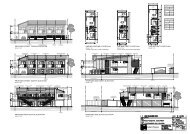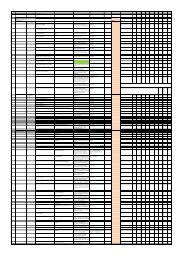specification for subdivision construction of road works and drainage
specification for subdivision construction of road works and drainage
specification for subdivision construction of road works and drainage
You also want an ePaper? Increase the reach of your titles
YUMPU automatically turns print PDFs into web optimized ePapers that Google loves.
R4.3.6 Joints <strong>and</strong> Junctions<br />
All longitudinal <strong>and</strong> transverse joints shall be well bonded <strong>and</strong> sealed. Hot longitudinal joints are<br />
preferred.<br />
Junctions between old <strong>and</strong> new pavements <strong>and</strong> joints between successive days' work shall be<br />
carefully made in such a manner as to ensure a thorough <strong>and</strong> continuous bond between the old <strong>and</strong><br />
new surfaces <strong>and</strong> to provide a smooth riding connection across the junction or joint.<br />
The exposed edges <strong>of</strong> each paver run shall be <strong>for</strong>med while hot with a dense face which may be<br />
between vertical <strong>and</strong> 451 to the vertical <strong>for</strong> the full depth <strong>of</strong> the layer. Rollers shall not be permitted to<br />
damage this face. Any segregated or open textured asphalt in such face shall be removed by cutting<br />
back the edge in a straight line to expose fresh, dense asphalt. The cut edge shall be between<br />
vertical <strong>and</strong> 451 to the vertical.<br />
All longitudinal joints shall be parallel to the centre line <strong>of</strong> the carriageway. Special care shall be<br />
taken in the <strong>for</strong>ming <strong>of</strong> longitudinal joints at ramp terminals <strong>and</strong> at all intersections to avoid joint<br />
layouts <strong>and</strong> an appearance that would tend to misdirect traffic from the designed travel paths. The<br />
plan <strong>of</strong> jointing in critical traffic path areas shall be approved by the Engineer prior to placing <strong>of</strong> the<br />
wearing course.<br />
Transverse joints shall be at right angles to the direction <strong>of</strong> spreading <strong>and</strong> cut to a straight vertical<br />
face <strong>for</strong> the full depth <strong>of</strong> the layer.<br />
When necessary, after asphalt has been placed by the paver along any abutting edge such as kerb,<br />
manhole or an adjoining pavement, just enough hot asphalt shall be carried back to fill any space left<br />
unfilled. This joint shall be properly 'set up' at the proper height <strong>and</strong> level to receive the specified<br />
compaction under rolling.<br />
Any longitudinal edge which is damaged by traffic or rolling shall be treated as set out be<strong>for</strong>e<br />
additional asphalt is laid alongside it.<br />
Where asphalt is required to match an existing surface, or other fixture, the Contractor shall place the<br />
asphalt in such a manner as to provide a smooth riding surface across the junction. Where required<br />
the Contractor shall remove sufficient <strong>of</strong> the existing pavement to enable a smooth riding surface to<br />
be constructed across the junction.<br />
Where it is necessary to re-sheet an existing asphalt surface in order to provide a smooth riding<br />
surface across the junction the section <strong>of</strong> tapering thickness asphalt shall end at a chase cut into the<br />
existing asphalt. This chase shall be approximately 25mm deep <strong>and</strong> 150mm wide, unless otherwise<br />
directed by the Engineer. When necessary, removal <strong>of</strong> coarse particles from tapering thickness<br />
asphalt will be allowed using h<strong>and</strong> raking.<br />
Where the depth <strong>of</strong> asphalt being placed in tapers is less than twice the size <strong>of</strong> the asphalt the area<br />
upon which such reduced thickness is to be placed shall be uni<strong>for</strong>mly covered with tack coat at an<br />
application rate <strong>of</strong> 0.50 l/m5 as directed by the Engineer.<br />
R4.3.7 Compaction Procedures<br />
After spreading, the asphalt shall be thoroughly <strong>and</strong> uni<strong>for</strong>mly compacted as soon as it will support<br />
the roller without undue displacement, other delays in rolling freshly spread asphalt will not be<br />
permitted.<br />
Where asphalt is being placed in layers <strong>of</strong> less than 100mm <strong>and</strong> greater than 25mm compacted<br />
thickness the following procedure shall be adopted <strong>for</strong> compaction unless otherwise directed or<br />
approved by the Engineer.<br />
Specification <strong>for</strong> Subdivision Construction <strong>of</strong> Road Works <strong>and</strong> Drainage<br />
Rev. 1 – February 2013<br />
38














